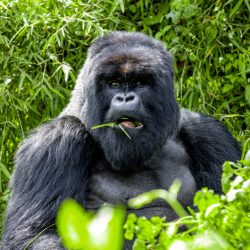Second phase of the on-going Bwindi mountain gorilla census is complete
Blog | 13/10/11
IGCP’s species coordinator, Dr. Augustin Basabose is back to his base in Goma, Democratic Republic of Congo after being part of the final training session for the census of Bwindi, as well as getting Team 2 started on data collection for phase 2. Phase 2 completed last weekend, and now we’re in the final stretch of the sweep through Bwindi to record nest counts and collect fecal samples for DNA analysis and health assessments.
Below he recounts his experience and his optimistic thinking about the population of mountain gorillas in Bwindi. But we won’t know for sure how the population of Bwindi has changed in the last five years until the data collected has been analyzed and cross-checked with genetics later in 2012.
—
We knew it is going to be an exciting exercise despite the fatigue which came due to the thorny climbing of numerous hills and slopping down deep valleys and crossing large swamps, which characterizes the Bwindi terrain. Given the importance of knowing the number the endangered mountain gorillas which were the reason for the exercise, it was an outstanding effort and perfectly worth it. We therefore are very proud to have participated.
I was leading the six-member Team 2 of the second phase for only five days before handing over to Charles, one of my brilliant students in Butare University, who lead the team for the other 7 days of the two-week period of the second phase. The involvement of local university students in the gorilla census fits well in our continuing effort of capacity building aiming to awake conservation leadership skills among committed gentlemen, expected to play a conservation key role in the region.
This second phase of the Bwindi gorilla census was indeed very exciting since it also involved staff from ICCN (Institut Congolais pour la Conservation de la Nature) who came from Kahuzi-Biega National Park, home to the eastern lowland gorillas, to join their efforts to undertake this trans-boundary conservation action along with their colleagues from the Uganda Wildlife Authority and the Rwanda Development Board to count the mountain gorillas inhabiting Bwindi Impenetrable National Park, a World Heritage Site.
The counting method consisted of sweeping the entire area by visiting and counting all the encountered fresh gorilla night nests, providing each weaned gorilla builds a nest every evening where he sleeps before leaving it and builds a new one for the next night. As for the previous Bwindi mountain gorilla census held in 2006, we collected fecal samples for genetic analysis to increase the accuracy in the counting the mountain gorillas ranging in Bwindi using genetic identities of individual gorillas.

Here we are collecting fecal samples for genetic testing. From left to right, Sunday, Charles, and myself.
The exercise was worth it. We have counted a number of gorilla groups and we should wait the end of the exercise, compiling the results from different teams before we disclose the total number of gorillas inhabiting Bwindi forest; however, the small area we covered yielded good findings and we are looking forward to getting the good insight into this population that the census affords.




